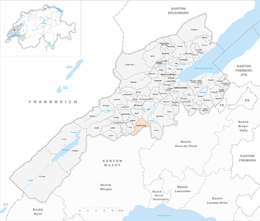Arnex-sur-Orbe
| Arnex-sur-Orbe | ||
|---|---|---|
 |
||
|
||
| Coordinates: 46°42′N 6°31′E / 46.700°N 6.517°ECoordinates: 46°42′N 6°31′E / 46.700°N 6.517°E | ||
| Country | Switzerland | |
| Canton | Vaud | |
| District | Jura-Nord Vaudois | |
| Government | ||
| • Mayor | Syndic | |
| Area | ||
| • Total | 7.61 km2 (2.94 sq mi) | |
| Elevation | 543 m (1,781 ft) | |
| Population (Dec 2015) | ||
| • Total | 621 | |
| • Density | 82/km2 (210/sq mi) | |
| Postal code | 1321 | |
| SFOS number | 5743 | |
| Surrounded by | Agiez, Bavois, Bofflens, Chavornay, Croy, La Sarraz, Orbe, Pompaples | |
| Website |
http://www.arnex-sur-orbe.ch Profile (French), SFSO statistics |
|
Arnex-sur-Orbe is a municipality in the Swiss canton of Vaud, located in the district of Jura-Nord Vaudois.
Arnex-sur-Orbe is first mentioned in 1049 as Arniacum.
Arnex-sur-Orbe has an area, as of 2009[update], of 7.6 square kilometers (2.9 sq mi). Of this area, 5.6 km2 (2.2 sq mi) or 73.6% is used for agricultural purposes, while 1.48 km2 (0.57 sq mi) or 19.4% is forested. Of the rest of the land, 0.49 km2 (0.19 sq mi) or 6.4% is settled (buildings or roads), 0.04 km2 (9.9 acres) or 0.5% is either rivers or lakes and 0.02 km2 (4.9 acres) or 0.3% is unproductive land.
Of the built up area, housing and buildings made up 2.2% and transportation infrastructure made up 3.7%. Out of the forested land, 18.0% of the total land area is heavily forested and 1.4% is covered with orchards or small clusters of trees. Of the agricultural land, 60.2% is used for growing crops and 7.4% is pastures, while 6.0% is used for orchards or vine crops. All the water in the municipality is flowing water.
The municipality was part of the Orbe District until it was dissolved on 31 August 2006, and Arnex-sur-Orbe became part of the new district of Jura-Nord Vaudois.
The municipality is located above the western Orbe valley.
The blazon of the municipal coat of arms is Argent, a cross Sable, overall crossed in saltire a key and sword Gules.
Arnex-sur-Orbe has a population (as of December 2015[update]) of 621. As of 2008[update], 8.8% of the population are resident foreign nationals. Over the last 10 years (1999–2009 ) the population has changed at a rate of 6%. It has changed at a rate of 1.3% due to migration and at a rate of 4.9% due to births and deaths.
...
Wikipedia



